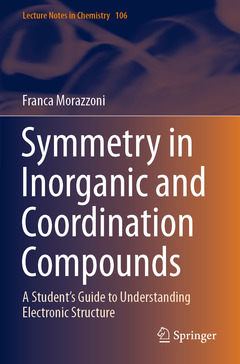Symmetry in Inorganic and Coordination Compounds, 1st ed. 2021 A Student's Guide to Understanding Electronic Structure Lecture Notes in Chemistry Series, Vol. 106
Auteur : Morazzoni Franca

This book addresses the nature of the chemical bond in inorganic and coordination compounds. In particular, it explains how general symmetry rules can describe chemical bond of simple inorganic molecules. Since the complexity of studying even simple molecules requires approximate methods, this book introduces a quantum mechanical treatment taking into account the geometric peculiarities of the chemical compound. In the case of inorganic molecules, a convenient approximation comes from symmetry, which constrains both the electronic energies and the chemical bonds. The book also gives special emphasis on symmetry rules and compares the use of symmetry operators with that of Hamiltonian operators. Where possible, the reactivity of molecules is also rationalized in terms of these symmetry properties. As practical examples, electronic spectroscopy and magnetism give experimental confirmation of the predicted electronic energy levels.
Adapted from university lecture course notes, this book is the ideal companion for any inorganic chemistry course dealing with group theory.
1. The electronic structure determination and its symmetry aspects
1.1 Variation method (MO LCAO)
1.2 Hückel requirements
1.2.1 The case of the allyl anion (MO-LCAO of π orbitals)
1.3 Extended Hückel procedure
1.4 Group Theory
1.4.1 Rules for the elements which constitute a group
1.4.2 Group multiplication tables
1.4.3 Representation of symmetry operations by matrices
1.5 Irreducible representations
1.5.1 Character Table of groups and reading examples
1.5.2 Factoring the total representation into irreducible representation
1.5.3 Relation between molecular wave functions and irreducible representations
1.5.4 Obtaining molecular orbitals with a given symmetry
2 . Symmetry orbitals for different di- and poly-atomic molecules
2.1 Homonuclear diatomic molecules A-B of the first row
2.2 Water as an example of triatomic molecule
2.3 Ammonia as an example of tetratomic molecule
2.4 Methane as an example of pentatomic molecule
2.5 Considerations about the models of chemical bond in use before the adoption of the symmetry molecular orbital model.
3. Perturbation theory
3.1 Interelectronic repulsion perturbation
3.2 Spin-orbit coupling perturbation
3.3 Crystal field perturbation
3.3.1- Use of group theory to predict the orbital spitting in a given symmetry
3.4 Electronic absorption bands
3.5 Crystal-field limitations
3.6 Effect of distortion from cubic symmetry
3.7 Table of characters to be used in the molecules reported in the text
4. Magnetism
4.1 Interaction between electrons and magnetic field
4.2 Magnetic susceptibility expression for S=1/2
4.3 Electron spin resonance
4.3.1 Hyperfine Nuclear Interaction
4.3.2 Hyperfine interaction by quantum mechanical approach
4.3.3 The electronic interaction with the magnetic field in oriented systems
4.3.4 The origin of the g anisotropic behaviour
4.3.5 g expressions for a d1 electronic configuration in tetragonal symmetry field
4.3.6 g tensor dependence on the energy level trend of the paramagnetic centres
5. Use of symmetry properties to describe the electronic structure of coordination compounds and minerals
5.1 Case studies
Prof. Franca Morazzoni earned her Ph.D. in chemistry at the University of Milano, becoming Associate Professor then Full Professor of Inorganic Chemistry at the University of Milano-Bicocca where she founded the group of hybrid nanomaterials in the Department of Materials Science in 2001. As an expert in physical methods in inorganic chemistry applied to hybrid materials, she has published more than 250 peer-reviewed papers in international journals. She has been responsible for leading several national research projects in the field, participating, most notably, in the development of novel inorganic nanofillers with controlled shapes in industrial collaboration with Pirelli Tyres, based in Milan, resulting in several patents on this topic. She was Vice Chair of the HINT COST action (2012–2016) on the topic of organic–inorganic hybrid interfaces. Prof. Morazzoni has supervised several Ph.D. students and, until 2015, was Director of the PhD School of the University of Milano-Bicocca.
Describes and compares chemical bonding in inorganic and coordination compounds using variation and perturbation methods
Shows how general symmetry rules can describe the chemical bond of even simple inorganic molecules
Provides a simple guide for students to use crystal field theory to understand electronic and magnetic spectra
Date de parution : 04-2022
Ouvrage de 185 p.
15.5x23.5 cm
Disponible chez l'éditeur (délai d'approvisionnement : 15 jours).
Prix indicatif 137,14 €
Ajouter au panierDate de parution : 04-2021
Ouvrage de 185 p.
15.5x23.5 cm



